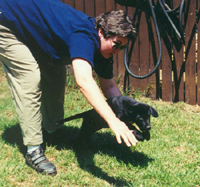



|
|
 |
||
 |
|
|
|
Puppy retrieving: getting started by John and Amy Dahl First Published by Tri-Tronics, Mark and Handle, May 1999 In this our first column for Tri-Tronics on retriever work and training, we start at the beginning, with puppy work. While most of us find puppy play to be a lot of fun, it is also a chance to build the foundation for a good attitude and streamlined learning later on. The wise trainer doesn't miss this opportunity. This month we will focus on the underlying goals of puppy work, and getting started with a little puppy only a few weeks old. In our next couple of columns, we will address introducing a puppy to water, birds, gunfire, etc., work for older puppies, and problems of puppyhood. To do a good job raising a puppy, it helps to keep in mind your goals for the pup whenever you start a training session. You want your pup to grow up to be confident, to be responsive to you, and to have plenty of initiative. Going overboard in pursuit of an immediate lesson usually is not compatible with these, so make a practice of using restraint. Don't try to exert complete control, but don't let your pup run wild and undirected, either. In particular avoid losing your temper. Young puppies are not rational creatures, and harsh treatment will teach them only to fear you. Punishment of any kind is pointless, as a young pup lacks the sophistication to understand it as a consequence of its behavior. Chances are everything your puppy does is normal puppy behavior, not spite or cussedness. Remind yourself of this frequently! The primary goal of all puppy work should be to condition your puppy to love retrieving. While many training procedures for adult retrievers use force, it is the positive reinforcement of making the retrieve that keeps the dogs working, and working happily, under force and pressure. We call it desire. Any experienced trainer will tell you that a dog which lacks desire has  limited potential. Every retrieving session needs to be planned
around the primary goal of building desire, and any immediate purpose that
conflicts with it must generally be abandoned. For example, almost all
good puppies decide at some point not to bring back the dummy or bird. You
could train your pup rigorously to come when called, then call it in on a
retrieve-but even if it doesn't drop the dummy on the way in, its
enthusiasm will be dampened. In a later article we will recommend some
strategies for getting the puppy back without discouraging it.
limited potential. Every retrieving session needs to be planned
around the primary goal of building desire, and any immediate purpose that
conflicts with it must generally be abandoned. For example, almost all
good puppies decide at some point not to bring back the dummy or bird. You
could train your pup rigorously to come when called, then call it in on a
retrieve-but even if it doesn't drop the dummy on the way in, its
enthusiasm will be dampened. In a later article we will recommend some
strategies for getting the puppy back without discouraging it. Getting your pup started retrieving is easy. Restrain the puppy with one hand across its chest while teasing it with a good retrieve object: a knotted white sock or a canvas puppy dummy. Wiggle the object enticingly a few inches in front of your pup's nose. When the pup is struggling to get at the dummy, flip it forward a foot or two and release the pup. Once your puppy gets the idea, you will be able to rapidly increase the distance of your throws. If you have trouble getting your puppy to come back to you, try throwing retrieves down a hallway where the only place it can go with the dummy is back past you. Outdoors, try running away from your pup once it gets the dummy in its mouth. Next month we'll give more detailed strategies to address the problem of getting a pup to come back without any harsh treatment.  The first key to building up the positively-reinforcing power of the
retrieve is to prevent your pup from getting bored. Retrieve sessions
should be very short, only two or three throws per session. Yes, we know
most puppies would happily retrieve all day-but all of them will lose
interest with repeated long sessions. If your pup's attention starts to
wander, or
after one good retrieve it drops the dummy and goes exploring,
you've done too much. Plan to do fewer throws next time.
The first key to building up the positively-reinforcing power of the
retrieve is to prevent your pup from getting bored. Retrieve sessions
should be very short, only two or three throws per session. Yes, we know
most puppies would happily retrieve all day-but all of them will lose
interest with repeated long sessions. If your pup's attention starts to
wander, or
after one good retrieve it drops the dummy and goes exploring,
you've done too much. Plan to do fewer throws next time. Retrieving must be not only fun for the puppy, but also more exciting than anything else it gets to do. This means you have to prevent it from indulging in, and developing a love for, other activites such as free play with other dogs. We have known extreme cases, puppies so excited about playing that the only way to get them to retrieve was to make them spend most of the day in a crate. It works. We have seen many a "happy idiot" become a die-hard waterfowl dog. You must maintain a high success rate. Your pup needs to develop confidence that if it sees something fall, it can make the retrieve. As your pup learns "the business," you will want to gradually increase distance, throw marks in cover, and generally provide more of a challenge. If your pup has trouble with a retrieve, or if it finds the dummy or bird after a long hunt, resist letting your pride make you repeat the challenge. Throw a mark you know it will find easily. Make sure your pup is always rewarded, not discouraged. As you progress in distance and difficulty, make sure your puppy's retrieves are not too demanding physically. Swimming is harder work than running, so retrieves in water should be correspondingly shorter than on land. If your puppy charges through some brush or briars, great-but don't repeat; give it another throw in a less punishing location. DO NOT have your puppy retrieve from cold water. You will build more toughness later on by not expecting toughness now. Although a good retriever always seems as though nothing could ever deter it from getting the bird, in reality the trainer should never take retrieving desire for granted. In later columns we will discuss planning training sessions so the immediate goal can be reached without discouraging the dog. Puppyhood, however, is the motivated trainer's golden opportunity to build a dog's desire, and its ultimate potential. Did you find this article helpful? A revised and expanded version is included in our new book on retriever training, The 10-Minute Retriever.
| ||||